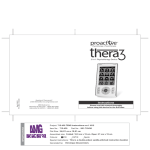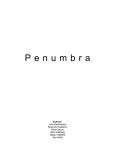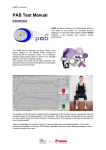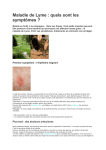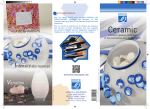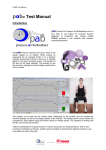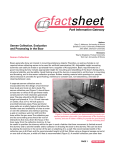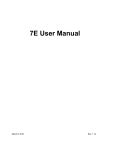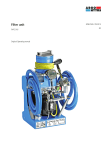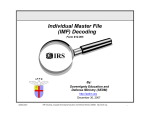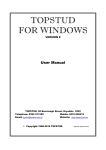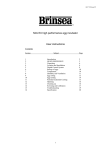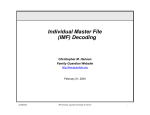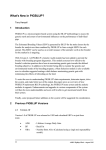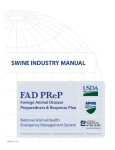Download BioSoft Toolbox® for Swine
Transcript
S W I N E S C A N NI NG L E S S O N N U M B E R 1 BioSoft Toolbox® for Swine Scanning for Marbling Scanning Swine for Marbling The purpose of this lesson is to describe proper procedures for ultrasound scanning of Inside This Lesson live swine to determine the amount of marbling in the pork loin muscle. The scientific anatomical name for this muscle is longissimus dorsi. Marbling can also be referred to as intramuscular fat (IMF) and is reported in the units of a weight percentage. A 1 Scanning Equipment 2 Age to Scan 2 Restraining the Pig 2 Scanning Site and Preparation 4 Aligning the Transducer 4 Freezing the Image 5 IMF Image Landmarks the images that are captured for each pig. The capturing of quality images requires 6 Region of Interest a significant amount of practice by the ultrasound technician. 7 Problem Images marbling score of 3 means that the muscle tissue of the longissimus dorsi has a total lipid percentage amount of 3% of the weight as compared to the total tissue sample weight. Texture analysis of B-mode ultrasound images taken on live swine is used to determine the amount of marbling or IMF in the loin muscle tissue. Software has been developed by Biotronics to perform this texture analysis on these images. For the most accurate determination of IMF, proper procedures and scanning protocol must be adhered to. The IMF estimation results will only be as good as the quality of Scanning Equipment The BioSoft Toolbox® for Swine works with images captured with the Aloka SSD 500V Equipment settings must be checked before the start of each scanning session. ultrasound scanner and when using the UST 5011 3.5 MHz linear array transducer. This software will not work with any other ultrasound scanner configuration. Biotronics, Inc. is working on software that will work with other scanner brands, and that technology will be released when available. Sophisticated texture analysis procedures are used to estimate the IMF amount in the loin muscle, so it is absolutely necessary that several equipment settings be made on the ultrasound scanner prior to scanning. The ultrasound technician must make sure that the settings are correct before each scanning session. It is also important to make sure that during the scanning session, settings are not accidentally changed. OVERALL gain (G), controlled by the large circular knob on the console left front face is to be set to G90 or its maximum value as shown in Figure 1. The slider controls located just above the overall gain knob control NEAR gain (N) and FAR gain (F). The NEAR gain is to be set to N-25, and the FAR gain is to be set to F2.1. These values appear on the console CRT display in the lower left corner as shown in Figure 2. Figure 1. Gain controls. This publication was developed by Biotronics, Inc. and has been reviewed for its correctness by Clint Schwab, PHD, Director of Commercial Services, National Swine Registry, P.O. Box 2417 West Lafayette, IN USA 47996 ©2008 Biotronics, Inc. All Rights Reserved. Copies Available From: Biotronics, Inc. 1606 Golden Aspen Drive, Suite 104 Ames, Iowa USA 50010-8011 [email protected] (515)-233-4161 PAGE 2 LESSON: SCANNING FOR MARBLING Magnification of the image size must be set to X1.5. This setting is controlled by a button on the front face of the console. The ultrasound scanner can be checked to make sure the magnification is correct by looking on the CRT display lower left hand corner (see Figure 2). Focus zones 1 and 2 must be enabled, with zones 3 and 4 in the ‘off’ position. Frame correlation is to be set to ‘auto’; contrast to ‘4’; and AGC to ‘1’. Refer to the Aloka SDD 500V User’s Manual for more information on properly setting the equipment. Figure 2. Gain and magnification settings. Age to Scan The IMF prediction software has been developed from images captured on pigs that are at a market weight of 250-280 pounds (113.5-127 Kg). In the USA, pigs achieve this weight by the time they are approximately six months old. At this age, most pigs will have a loin depth that is sufficient for texture analysis to determine the IMF. Also, at this weight and age, pigs will have expressed their individual genetic potential for IMF. Quality images can only be captured from properly restrained pigs. There are no assurances that the software will work for pigs that are not generally of the six month age and at the weight range given above. The BioSoft Toolbox® for Swine will work equally well for barrows, gilts and young boars in the determination of IMF. This software can be used with all swine breeds and crosses. Restraining the Pig Quality ultrasound images can only be captured from pigs that are properly restrained. The pig must be confined to a crate that will restrict its forward, rearward, and lateral movement. The pig must be also be restrained so that it is not able to raise its head above the top of the crate or to climb out of the crate. Quality images can only be captured when the pig is near motionless. Some technicians have developed a mechanical bar that goes between the legs of the animal (from front to back) and can be raised to elevate the pig off of its feet. An example crate with a raising bar that was developed by swine researchers in Canada is shown in Figure 3. This is an extremely useful innovation that contributes not only to capturing excellent quality images, but to the safety of both the pig and the technician. This innovation also cuts down considerably on the amount of time required to scan the pig, and minimizes the stress level of the pig. Scanning Site and Preparation The region of scanning for IMF is directly behind the front shoulder of the pig, and at approximately 5 cm off the midline. The pig can be scanned on either the left or right side; however, it is important that all pigs within a contemporary group be scanned on the same side. the Figure 3. Restraining crate for scanning pigs. 13th The region of scanning will extend over the 9 th through ribs where the numbering starts at the anterior (forward) position. This entire region needs to be cleaned thoroughly and free from any dirt or other debris. If the pig has a very thick hair coat, it may be necessary to clip the hair so that the ultrasound signal can be transmitted without excessive reflection or absorption. ©2008 Biotronics, Inc. All Rights Reserved. LESSON: SCANNING FOR MARBLING PAGE 3 Technicians may find it convenient to position the crate and a table for the ultrasound equipment as shown in Figure 4. This configuration allows the technician to both observe the image that is being captured and the positioning of the transducer on the back of the pig at the same time. Figure 5 is the skeleton of a mature porcine that has 14 ribs with the most posterior rib numbered as 14. The red colored bracket is located over the 12th through the 9th ribs, and this is the position for placing the transducer for the IMF image. The red line in Figure 6 is showing the similar position. Figure 4. Scanning crate and equipment setup. 14th rib Figure 6. Position of the transducer for the IMF image. Figure 5. Skeleton of a mature porcine. After cleaning the scanning site, a vegetable oil couplant must be liberally applied to the skin surface. It may be necessary to reapply the couplant from time to time during the scanning of each pig. Soybean oil makes a very good type of couplant; however, other oils such as corn oil can be used effectively. Acoustic gel is generally too expensive to be used as a scanning couplant for animals. The couplant allows the ultrasound signals to easily go through the skin and into the tissues below the skin surface. Air pockets between the transducer and skin surface will reflect most of the ultrasound energy before it reaches the skin. Technicians may have their own preference for holding the transducer when scanning for IMF, however, the method shown in Figure 7 allows a significant amount of control. The transducer is cradled between the thumb and the index finger, and grasped just behind the cord that exits the transducer on the top side. Notice that the fingers are touching the skin of the animal and are used to Figure 7. Hand position for holding the transducer. help steady the transducer as it is moved laterally at the top to reduce the magnitude of echoes (if present in the image). ©2008 Biotronics, Inc. All Rights Reserved. PAGE 4 LESSON: SCANNING FOR MARBLING Aligning the Transducer The ultrasound transducer is to be aligned parallel with the midline of the pig and approximately 5 cm off the midline as shown in Figure 8. The transducer should also be almost perpendicular to the skin surface. For smaller pigs, the transducer may need to be placed closer to the midline at 4 cm and for large pigs further from the midline. The objective is to have the image (called a longitudinal image) captured at the cross-sectional midpoint of the longissimus dorsi muscle as shown in Figure 9. It is also important that the image shows the longitudinal image with a near maximum loin muscle depth. Artifacts of ultrasound that need to be minimized or eliminated are what are referred to as echoes. Echoes are mirror reflections of tissue interfaces caused by very strong signal returns. Echoes can be minimized by slightly tilting the transducer Figure 8. Scanning for IMF. so that it is not directly perpendicular to the surface of the skin. In some cases the echoes can be completely removed from the image, while in other cases, they can only be reduced. Traditionally, the texture analysis for IMF is done within the region of the ultrasound image that is between the 10th and 11th ribs of the animal (as counted from the anterior end of the animal). This is the anatomical location at which the trapezius muscle will be only slightly visible in the image. Technicians are to use the trapezius muscle as an IMF image reference ‘landmark’. The posterior end of the trapezius muscle lies above the 10th rib on most pigs, making it a valuable reference point. Without the tip of the trapezius muscle appearing in the image, there is no way to be sure that the 10th rib can be correctly identified as the rib tops all look alike. More discussion on this point is found in the Figure 9. Scanning plane for the IMF image. Problem Images section. Freezing the Image A remote ‘freeze’ switch can be provided with the Aloka SSD 500V. This switch is held by one hand of the scanning technician, and the transducer is held in the other hand as shown in Figure 10. The technician will be watching the image on the console CRT to determine when the transducer is in the correct location, and when a quality image can be frozen by pressing the freeze switch. If the image is not of good quality, then the image is released by pressing the freeze switch a second time. Images that are not of high quality should never be captured by the BioSoft Toolbox® software. Evidence of a poor quality image include, but is not limited to the following: (1) the appearance of a blurring of the image, (2) poor contact of the transducer on the skin, (3) dark regions in the image, (4) bright echoes, and (5) electrical interference as seen by periodic and repeating lines in the image that are non- anatomical Figure 10. Transducer alignment and freeze switch. features. ©2008 Biotronics, Inc. All Rights Reserved. LESSON: SCANNING FOR MARBLING PAGE 5 IMF Image Landmarks IMF image landmarks provide the technician with the information needed to judge the quality of a frozen image. The skin and three fat layers will generally be easily identified in the image. For pigs with external fat of less than 10 mm, the third fat layer may not be distinguishable from the second fat layer The image should display diagonal features or striations that are the individual muscle fiber interface boundaries. These striations always move downward at a diagonal slant and toward the head of the pig. For pigs with a large amount of external fat, and for pigs that have high IMF levels, the striations will be less visible than in a less fat pig or in one with a lower IMF level. Five to 7 quality IMF images must be capture per pig for the highest accuracy. As shown in Figure 11, the tops of the ribs should be well defined in the image. The intercostales muscles that anatomically attach the ribs together should appear distinct and clear in the image. The most posterior end of the trapezius muscle should be showing in the image. This end will be used in defining the position of the 10th rib. As the technician drops an imaginary line down from the trapezius end, the line will intersect or come very close to the 10th rib. The technician should capture between 5 and 7 quality images for each pig scanned using the BioSoft Toolbox® for Swine capturing software. It is important to capture more than one image for purposes of improving the accuracy of the IMF determination. Through research, it has been found that 5 to 7 images will provide the best opportunity for the highest accuracy. An IMF value will be determined for each image within an animal, and then the individual image IMF values are averaged across all of the images within that animal. The interpretation software allows up to 10 images per pig. This should allow for an ample number of images if some have to be ignored because of poor quality during the interpretation process. Posterior end of the trapezius muscle Muscle striations Rib tops 10th 11th 12th Intercostales muscles Figure 11. A high quality IMF image. ©2008 Biotronics, Inc. All Rights Reserved. PAGE 6 LESSON: SCANNING FOR MARBLING Region of Interest Texture analysis is done within a user-positioned region of interest (ROI) for each IMF image when using the BioSoft Toolbox® for Swine. The ROI is a square box that will appear on top of the image when it is being interpreted. The objective of every scanning session for IMF is to capture images that will allow proper ROI box positioning and texture analysis. The objective of every scanning session is to capture images that will allow proper ROI positioning and texture analysis. The ROI box is manually positioned by ‘dragging’ it with the computer mouse. There are two sizes of ROI boxes that can be selected for use within the BioSoft Toolbox® for Swine interpretation software. The box that will maximize the ROI size without the box being positioned directly on rib tops or over echoes should be selected. If this is not possible, the technician should choose a smaller ROI box size. The ROI position should normally be placed above and between the 10th and 11th ribs. Deviations from this may be required because of dark regions that need to be avoided or because the echoes are too prominent. The objective is to find the ‘best’ region and largest region that outlines a homogenous texture for analysis. Sometimes there are bright ‘spots’ that will appear within the ROI. These can be caused by sound reflections off of the rib tops that move upwards in the image and that tend to magnify the intensity of the muscle striations. These bright spots should be avoided if possible. The longitudinal image shown in Figure 12 has a region of interest (ROI) box that has been manually computer positioned mouse. This ROI with box a is positioned almost directly between the 10th and 11th ribs. There is just a very small tip of the posterior end of the trapezius muscle showing in this image. The ROI does not include any rib tops. The ROI is also located below the artifact echoes appearing in this image. It can be seen that the texture of the image within the boundaries of the ROI box is homogeneous. Images captured for determination of IMF must be of the quality shown in Figure 12. It is to be noted that this image should have been improved by the technician by minimizing the echoes. However, the echoes do not intersect the ROI, and Figure 12. IMF image with region of interest (ROI). therefore, they will not affect the accuracy of the IMF determination. ©2008 Biotronics, Inc. All Rights Reserved. LESSON: SCANNING FOR MARBLING PAGE 7 Problem Images Images that exhibit problems are going to reduce the accuracy of IMF determination for the pig. Examples of common problems are shown in the following pictures. For most cases, images with these problems should not be used in the determination of IMF. An understanding of the anatomy of the pig is required before a technician can repeatably capture quality IMF images. Many problem images can be avoided if the anatomy of the pig is understood. Trapezius muscle Images that have been captured with incorrect equipment settings are to be discarded and not used in the determination of IMF. Too Much Trapezius Muscle Figure 13. Cross-sectional picture at the 5th rib (photo courtesy of Clint Schwab). Spinalis dorsi muscle The image shown in Figure 14 is taken too far forward on the animal. This is evidenced by the amount of trapezius muscle and the spinalis dorsi muscle that are shown in the image. A properly collected IMF image will not contain any of the spinalis dorsi muscle and will contain only the posterior tip of the trapezius muscle. The box shown in the image contains the posterior end of the trapezius muscle. 8th Rib Figure 14. Image with too much trapezius muscle. ©2008 Biotronics, Inc. All Rights Reserved. PAGE 8 LESSON: SCANNING FOR MARBLING Correct Amount of Trapezius Muscle Trapezius muscle 10th rib top The image shown in Figure 15 is a properly captured IMF image. Just the posterior end of the trapezius muscle is showing. It can be seen that the 10th rib is almost directly below this posterior end. The ROI for interpretation of IMF is placed between the 10th and over the top of the 11th rib. The ROI is always positioned so that it does not contain rib tops, fat layers or echoes. It is important for the texture within the ROI to appear consistent and homogeneous. Figure 15. Image showing the correct amount of trapezius muscle. Acceptable Image The image shown in Figure 16 is an acceptable image. Just the tip of the posterior end of the trapezius muscle is shown in the image. There are no echoes appearing in the longissimus dorsi (loin muscle) part of this image. This is a relatively fat pig, with a narrow loin depth. This image will require a smaller ROI than the image shown in Figure 15. changed The size of the ROI can be during the image interpretation process. Note the consistent texture that appears within ROI. Figure 16. Acceptable Image. ©2008 Biotronics, Inc. All Rights Reserved. LESSON: SCANNING FOR MARBLING PAGE 9 Poor Contact Poor contact The image shown in Figure 17 has several problems. A major problem is that there is not good contact between the ultrasound transducer and the skin of the pig. It could be that the pig moved at the instant the freeze switch was depressed. It is also possible that there was not enough couplant applied to the skin of the pig. Images that look like this should not be interpreted for IMF. This image also has the appearance of being blurred. intercostales The muscles rib tops and are not well defined. This image should not be used to determine IMF. Figure 17. Image with poor contact. Acceptable Image The image shown in Figure 18 is of acceptable quality to predict IMF. The posterior tip of the trapezius muscle is easily identified, and there are no echoes in the location where the ROI is positioned. Figure 18. Acceptable image. ©2008 Biotronics, Inc. All Rights Reserved. PAGE 10 LESSON: SCANNING FOR MARBLING Blurred image The image shown in Figure 19 is what is referred to as a blurred image. An unblurred image taken on the same pig is shown in Figure 20. Sometimes blurring is very subtle, and only the experienced eye can determine that an image is blurred. Having an unblurred image on the same animal makes the determination much easier. In this case, one can see that the image in Figure 20 is much more crisp and sharp than the image shown in Figure 19. Blurring occurs when there is movement of the transducer at the same time the image is frozen. This can be cause by movement of the pig, or because the technician moved the transducer at the Figure 19. Blurred image. instant the freeze switch was pressed. Blurred images should never be interpreted for IMF as the result will not be accurate. It is to be noted that there is no trapezius Image without Blurring posterior end showing in the image of Figure 20. So even though the image is not blurred, it is not a good image because without the trapezius end showing, it is impossible to determine which is the 10th rib. It is suspected that this image is collected too posterior on the animal, and the transducer is over the 14th, 13th and 12th ribs (the 14th rib being the left-most rib). There are echoes appearing in the image in Figure 20, however, the loin depth is sufficient for position of the ROI without any problems. Note the direction of the diagonal muscle striations. They are going from left to right in the image meaning that the head of the pig is to the right of this image. The technician has reversed the direction of the probe to capture these images (see the red circle). Figure 20. Image without blurring. ©2008 Biotronics, Inc. All Rights Reserved. LESSON: SCANNING FOR MARBLING PAGE 11 Echoes and Noise Interference The image shown in Figure 21 has echoes within the region where the ROI should be placed. caused by The echoes are the strong interface reflections between the fat layers. Echoes can be minimized by slightly tilting the transducer on the surface of the skin and so that the alignment is not directly perpendicular. This image is also showing some type of signal interference or noise streaks. These streaks can be seen in the dark regions and in the shadow of the rib tops. Some of the streaks are circled in red. Images with interference should not be interpreted for IMF. This image is also missing the tip of the trapezius muscle. Figure 21. Image with echoes and interference or noise. Acceptable Image The image shown in Figure 22 is an acceptable image. The posterior end of the trapezius muscle is showing in the image. The rib tops are clearly defined along with the intercostales muscles. The scanning technician should use the image shown in Figure 22 as their ultimate image quality objective. With a set of images like this for every pig, the accuracy of IMF prediction will be 10th 11th 12th enhanced. Figure 22. Acceptable image. ©2008 Biotronics, Inc. All Rights Reserved. PAGE 12 LESSON: SCANNING FOR MARBLING Poor Rib Top and Intercostales Definition The image shown in Figure 23 has several problems. It has two dark regions, indicating that there was not sufficient couplant between the transducer lens and the skin of the animal. The rib tops and intercostales muscles are not well defined in this image. There is no evidence of the trapezius muscle, and the technician should have minimized the echoes. This image should not be used to determine an IMF value. Figure 23. Image with poorly defined rib tops and intercostales muscles. Acceptable Image The image shown in Figure 24 is an acceptable image and can be used to determine IMF. There is some evidence of echoes in this image, so a small ROI should be used so that the echoes do not intersect or appear within the ROI. The posterior end of the trapezius muscle is present in this image. The rib tops and intercostales muscles are well defined. Figure 24. Acceptable image. ©2008 Biotronics, Inc. All Rights Reserved. LESSON: SCANNING FOR MARBLING PAGE 13 Dark Regions The image shown in Figure 25 has several problems. One of the major problems is that there are several dark regions. One of the dark regions is outlined with the red oval. Dark regions can be caused by several different things. Usually, it means that there is not enough couplant between the transducer lens and the skin of the animal. It could also mean that the skin is dirty and needs to be cleaned. Two other reasons include that one or more transducer crystals may not be functioning or that excessive hair is causing attenuation of the ultrasound signal. Other problems in this image include excessive echoes and some type of noise or electrical interference. Also, the Figure 25. Image with dark regions. posterior tip of the trapezius muscle is not showing in the image. Acceptable Image The image shown in Figure 26 is an acceptable image and can be used to determine IMF. The posterior end of the trapezius muscle is present. The rib tops and the intercostales muscles are clearly defined. The region where the ROI is placed contains a very consistent and homogeneous texture. Figure 26. Acceptable image. The BioSoft Toolbox® for Swine is a revolutionary set of software programs allowing swine breeders to capitalize on the opportunity of improving compositional and quality traits with the noninvasive attributes of ultrasound. These programs are state-of-the-art with the latest in technology and advanced texture analysis processing. The development has been accomplished by animal scientists and engineers with more than 60 years combined research and development experience in ultrasound technology. For more information, contact Biotronics, Inc. at [email protected]. ©2008 Biotronics, Inc. All Rights Reserved.













